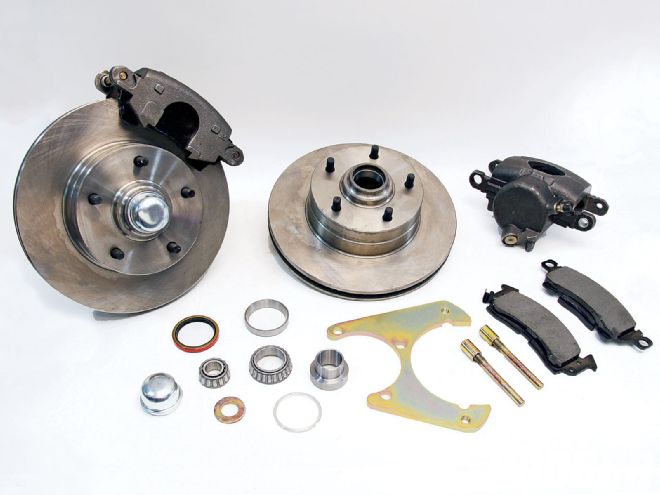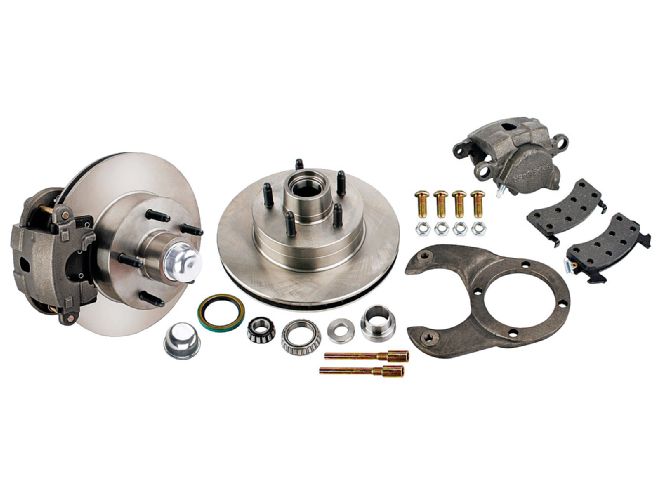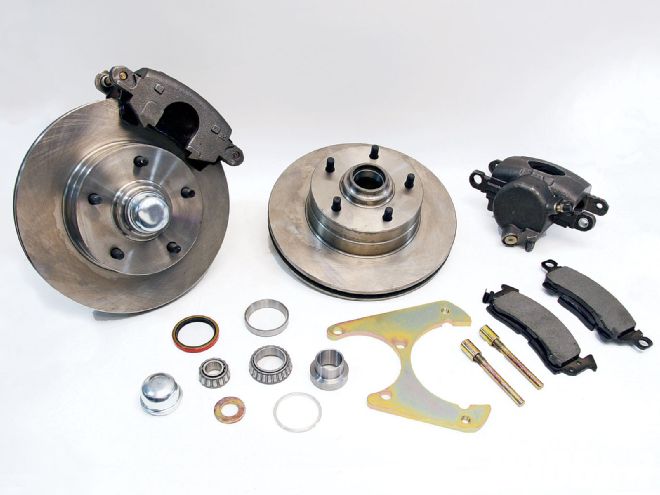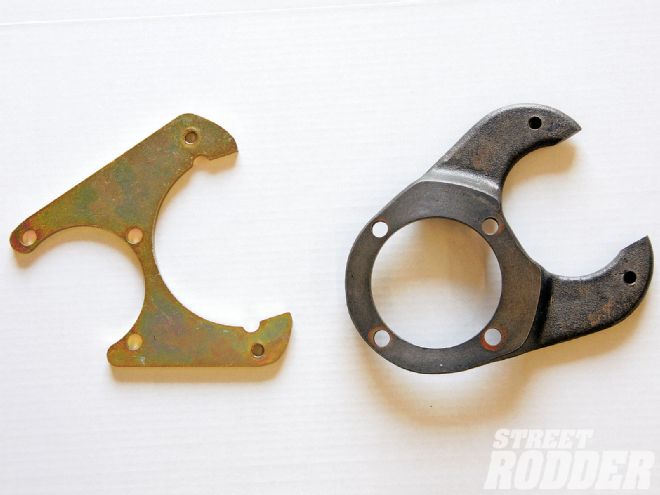
It is truly joyous when a rodder is finally able to get his chassis up and off the ground and converted into a roller. Though the obvious ability to now move it to the side of the shop while you work on other, non hot rod stuff might have its downsides, seeing your project up on all four wheels for the first time is actually a momentous occasion.
 Here is Speedway's 910-31946 brake package, which features the smaller '77-88 GM metric calipers to be used on the '37-48 Ford spindles with bolt-on steering arms. A set of 11-inch discs are included here, too, along with all the other new pieces needed to completely assemble a disc brake system.
Here is Speedway's 910-31946 brake package, which features the smaller '77-88 GM metric calipers to be used on the '37-48 Ford spindles with bolt-on steering arms. A set of 11-inch discs are included here, too, along with all the other new pieces needed to completely assemble a disc brake system.
But you can't make it a roller until you decide what the theme of the car will be. Traditional? Contemporary traditionalist? New age independent? For example it would look goofy to run drum brakes on a swoopy car that features an independent front suspension and, conversely, running oversize disc brakes on an I-beam-based traditional rod just plain looks wrong.
But would you run drums or disc brakes in this situation? You have a four-link suspension already in place and you're running '60s-era hot rod wheels with a dropped tube axle-a kind of late-'70s look. Since you already have the four-bar setup in place it's already non-traditional, so disc brakes probably would be the way to go (plus the performance gain in running discs instead of drums is another plus).
But when we recently decided to install disc brakes for a Model A roadster pickup chassis, we were surprised to find there were still many more choices to be made. We contacted Speedway Motors for one of their affordable disc brake kits and saw they offered many types, depending on whether you were using Wilwood or GM calipers, Chevy spindles or Ford, aftermarket bolt-on steering arms or stock arm-attached spindles, or even Chevy bolt pattern wheels versus early or late Ford bolt patterns. They even had us covered out back, as they sell several types of rear disc brake conversion kits too.
 Here is Speedway Motors' 910-31942 kit that features the "big" '69-77 GM 4 3/4-inch calipers to be used with the '37-48 Ford spindles and bolt-on steering arms. New 11-inch discs, brake pads, calipers, bearings, seals, and more are included.
Here is Speedway Motors' 910-31942 kit that features the "big" '69-77 GM 4 3/4-inch calipers to be used with the '37-48 Ford spindles and bolt-on steering arms. New 11-inch discs, brake pads, calipers, bearings, seals, and more are included.
But it looked like the only thing we needed to supply Speedway's order desk was the info on what kind of spindles we would be using (ours are aftermarket '37-48 round-type Ford spindles with bolt-on steering arms) and what the bolt pattern was for the wheels (in our case: Chevy 5x4 3/4). But again we were surprised to find they have two different kits (PN 910-31946 for about $300, and PN 910-31942 priced roughly at $200) for the exact same application. So we looked a little closer at the two kits, and saw they come with nearly everything you would need (including new 11-inch rotors, brake pads, caliper mounting brackets, bearings and seals, bolts) but the major difference was whether you wanted a big or small GM caliper.
Speedway Motors offers a kit for our application with either an early '73-77 "big" GM caliper or the '78-88 small "metric" GM caliper. Either will work but there are several factors to consider. The 910-31942 kit will increase the track width of the car, which may be a factor for a car with fenders and, with its larger caliper, 14-inch wheels, and other wheels not designed for disc brake systems might not fit. Also, it's a little bit heavier than the other kit, and the additional unsprung weight will affect handling and road feel on lighter cars. Plus Speedway doesn't usually recommend the 910-31942 kit for Model Ts, As, or the '33/34 Fords, preferring it to go on heavier fat-fendered cars.
Another difference between the kits is since there is an overall size difference in the calipers, there are also differences in the size of the caliper piston as well as with the surface area of the disc brake pad themselves (i.e. smaller pads with the small-caliper kit). But either kit, with calipers, discs, and pads designed to stop a large 3,500-pound GM vehicle of the '70s being used to slow a 2,100-pound Model A roadster pickup, then for some it might just come down to aesthetics. Overall, the differences between the two are minor, so we thought we'd show what they are and how they are installed.
 The 910-31942 (or "942") caliper bracket is on the left, the 910-31946 (or "946") bracket is on the right. The 946 bracket is truly a bolt-on piece, while there is some clearancing that needs to be done with some parts to make the 942 bracket fit.
The 910-31942 (or "942") caliper bracket is on the left, the 910-31946 (or "946") bracket is on the right. The 946 bracket is truly a bolt-on piece, while there is some clearancing that needs to be done with some parts to make the 942 bracket fit.
One special note: Between travelling to different shows for the magazine and waiting for a slot to open up in our tech center where the work was done, the rotors we received from Speedway got a little surface rust on them. Upon hearing an old wives tale that Coca-Cola removes surface rust, we thought we'd try it on the rotors, but it didn't work. It added a film coating that could be barely scratched off-it seemed almost like a gun bluing. So we ended up sand blasting them at Dave Greiner's Proformance Motoring to get them to look presentable. Rest assured: the rotors that you receive from Speedway Motors will look much better than our Coke-stained, bead-blasted rotors turned out!